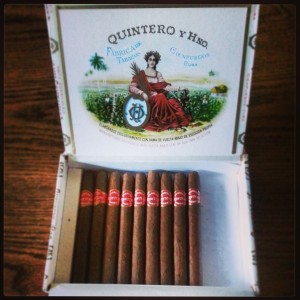On Cigars
For a change of pace I thought we’d talk a little about cigars. I’ve been a cigar smoker for many years now and along the way I’ve picked up some interesting knowledge and smoked a lot of great cigars. So, to break slightly from the stresses of the news and politics I’ve decided to discuss something that’s a symbol of recreation and status.
I’m sure a lot of us know someone who enjoys a cigar from time to time, whether they’re a relative, a friend, or an historical figure. Some of the greats in history have been cigar smokers – Freud, Churchill, Liszt (just to name a few). Though they aren’t for everyone, cigars are a thing of relaxation for those who partake of them. During the boom of cigar popularity in the US cigars were seen as a symbol of success and power; often smoked after dinner over talks of politics and business by many influential men, and to the present day they are still seen by many to be the same. Though when they made a big impression in the states after journeying northward from Cuba and Central America the demand arose for an affordable cigar that could be enjoyed by average, everyday people. This broadened the cigar market immensely, and has brought us a wide range of prices and qualities of cigars to this day.
Though tobacco has been smoked by many groups of people in many parts of the world for ages, the cigar was perfected in Cuba specifically. The best of the best was, and still is, entirely handmade. A cigar is comprised of different types of tobacco leaves. The tobacco plants are grown in different types of soil, in different climate variations, and different parts of the plant are used to made different parts of a cigar. The leaves are aged for varying amounts of time and in different ways, all of these differences producing vastly diverse flavors and types of cigars. So, once the tobacco plants are grown to maturation the leaves are picked and aged, generally in large barn rafters, for up to a number of years. A quality cigar is comprised of three main parts: fillers, binders, and a wrapper. Different types and ages of leaves are used for these components to create unique flavor complexes for each cigar in a process called blending. Cigar makers are always coming up with new blends of tobaccos and even different added flavors to offer a new and unique smoking experience. In Cuba all of the leaves required to build the cigar are usually put together by hand, and by quality control standards these cigars are labeled “Totalmente a mano“, meaning that they are made “totally by hand.” There are other cigars that you’ll find that are labeled “Hecho a mano” to denote that they are handmade, however this generally means that portion of the process was done by hand while the rest was completed by a machine. These cigars are the ones available in the states today, due to the fact that totalmente a mano cigars are almost exclusively produced in Cuba. Often in Cuba cigar rollers who hand craft the cigars use vintage tools for cutting and rolling the tobaccos into cigars that are in their families for generations. These rollers are called torcedores.
This brings us to the prestige and desirability of Cuban cigars. Cuba, having pretty much launched the cigar, is said to produce the best cigars in the world. However, those of us who remember a little Cold War history will remember things like the Cuban missile crisis during the Kennedy days and the subsequent trade embargo that was placed on Cuba. This makes it illegal to import anything Cuban, naturally including their cigars. A lot of retailers out there sell what they claim to be Cuban cigars, however there is really no way to be certain if they’re the real thing. The only way for an American to obtain irrefutably authentic Cubans is to do so outside of the US. They are available for purchase pretty much anywhere else, including Canada. In Canadian tourist areas, however, the price of Cuban cigars is generally marked up due to the understanding that many Americans will buy them while travelling. Somewhere in Europe would be a better place to pick up Cuban cigars if you’re abroad and interested in trying them.

Quintero y Hermanos, a brand of Cuban cigars. From my personal collection, bought in Germany.
After the US embargo on Cuba a lot of the major cigar families opened factories in other South and Central American countries, the most popular of which are the Dominican Republic, Nicaragua, and Honduras. Original Cuban brands such as Montecristo, Romeo y Julieta, H. Upmann, Punch, and so on are now also made in the Dominican Republic and these are the versions available in the states. As to whether or not the quality of the Dominican variants of the Cuban originals varies, it’s hard to say. Some swear by the rarest, most expensive cigars while other’s prefer more common brands. Like most everything else, it’s honestly a matter of personal preference. Some say that Cuban cigars lost their unique superiority in the 60’s due to changes in blending and the tobacco used and that they are now no different flavor- and quality-wise than the others. I’ve personally tried a few Cubans in my day, some of which are pictured above, and I could swear I noticed a unique flavor. Though, it could just be my imagination.
So now that we’ve gone over the background of the cigar itself, which cigars are good to smoke? Well, like I said earlier, it’s all about personal taste. The most important thing to know as a first-time cigar smoker is that you do not inhale the cigar smoke. Letting it linger in your mouth is sufficient to allow the nicotine to relax you. In choosing a cigar to smoke as an introduction to cigars, size is probably the most important. If you’re uncertain about whether or not you’ll like it, go with a smaller size like what’s called a corona or a robusto. There are a set of specific names for cigar sizes and dimensions that most cigars use, however brands will commonly come up with their own names for the different sizes.
The name for a larger sized cigar, one which is generally around 6 inches long, is a Churchill, named for Sir Winston Churchill himself. Being a heavy smoker, Churchill needed larger cigars than were widely made at the time, so he had ones made especially for him that were about twice the size of the average cigars in those days.
Along with size, price is among the most important points when it comes to selecting a cigar. Many novice cigar smokers will pick out the cheapest smoke they can find for their first cigar, the quality of which may turn them off of smoking again in the near future. If it’s a special occasion prompting you to try a cigar and you have the money, I’d recommend going for something above $4-$5 or more per stick (single cigars are referred to as sticks).
After those points, the other details only come into play if you’ve smoked some cigars in the past and know what kinds you like. Some of these details include the type of wrapper on the cigar, which determines the flavor and strength of the smoke. A lighter shade wrapper generally denotes a milder cigar, whereas a darker shade generally denotes that it’s bolder. In my experience a darker shade such as a maduro or oscuro wrapper is enjoyable for the fact that when you initially light it the first few puffs aren’t as hot on the palate as those of a lighter shade. Also, if your cigar burns out before you’re finished and you have to relight it, a darker shade tends to relight more easily without tasting harsh. As I mentioned earlier, the wrapper is only one component in the cigar; the filler and binder are important as well in determining the strength and body of the smoke. Sometimes a cigar is referred to as a double or triple when referring to the wrapper, such as a double or triple maduro (MX2 or MX3). This means that not only is the wrapper of the cigar that type of leaf, but also the binder and/or filler – these cigars tend to have a bold flavor.
Another important thing to remember is that bold cigars are best smoked on a full stomach. Cigars are sometimes known to turn the smoker’s stomach if the cigar is bold and their stomach is empty. However, this can happen at random as well. Just pace yourself and if you begin to feel relaxed slow down a bit. The only way to get through a cigar sickness is to just lie down and wait it out.
As for my personal preference, my favorite cigar brand would have to be Gurkha. Their presentation and their boxes and bands (the labels around each cigar) are designed with superior quality and attention to detail. They are known for putting great effort into their visual branding, making Gurkha cigars very noticeable. The cigars themselves are very seldom any less than great, in my opinion. Their construction is sturdy, so they smoke consistently, burn evenly, and don’t split open often in extreme temperatures. Their blends are always very unique and flavorful and they produce a good quality of smoke. Some of their lines that I enjoy are the Gurkha Ghost, which has a very dark wrapper and a spicy flavor, however it’s never overpowering. Another standby is the Gurkha Royal Challenge, which has a lighter wrapper and is a milder smoke, but has a great flavor complex and also smokes very well. Because of the quality of the cigars themselves and the the funds put into their attractive bands they can be a little on the expensive side. However, they offer some more cost-effective off-shoot lines that are still made by K. Hansotia, the founder of Gurkha and sold by large retailers such as Cigars International. One of these cigars is the Gurkha Park Avenue, available in a light (called Connecticut) wrapper and a maduro. They are about $60 for a box of 20, which is a very good value for cigars, and their quality is no less than the larger flagship lines that Gurkha produces.
So, now that you know everything about cigars, go out and smoke one. As for other cigars that I’ve smoked and comments about them, I plan to put together some reviews in the future to post in small groups here and there, so if the topic interests you be sure to check back for follow-ups to this topic. For those of you who aren’t interested in cigars, if you’re this far along this you’ve at least taken the time to read the whole article, for which I’m grateful. But if you decide to take the leap into smoking cigars you might be pleasantly surprised.

